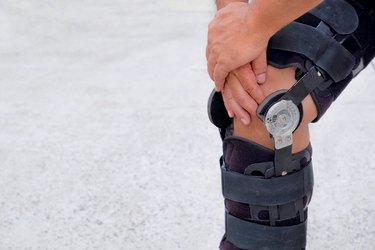
Knee injuries are a common hazard in almost every sport. Like other major joints, knees combine several bones, muscles and ligaments in a confined space. However, knees endure more strain than many other joints because they support the body's entire weight.
They're also required to support frequent changes of direction, sudden impacts and many other powerful, transient stresses. An open patella knee brace can be used both to help prevent knee injuries and to support injured knees as they heal.
Video of the Day
Video of the Day
Understanding Knee Braces
There are several types of knee braces, designed to serve different roles. It can be difficult to know whether you need a knee brace without a hole or with one. The most substantial models have rigid metal frames to restrict the knee from twisting or being bent sideways.
More commonly, braces are made from an elastic material that bends and flexes with the leg, providing support without restricting the user's range of motion. Basic models are made of dense bandage-like elasticized fabric, while better quality braces are made from stronger substances such as neoprene.
Manufacturers of knee braces use a variety of features to differentiate their own products, but in general most knee braces can be described as open patella or closed patella.
Open Patella Knee Brace
Open patella knee braces, as the name suggests, leave the patella or kneecap uncovered. Some models are completely open in front, while others have a small reinforced opening just large enough for the patella.
Advocates of open patella braces consider them more comfortable for extended wear than closed patella braces, which take the form of a continuous tube of supportive material.
Closed patella knee braces can sometimes cause or aggravate knee injuries by applying pressure to the patella during a workout and causing it to move off-center or rub against the underlying joint.
Many open patella braces are designed specifically to support the patella as a secondary benefit, holding it in proper alignment relative to the rest of the knee joint. This can be beneficial if you have an unstable kneecap, according to the American Academy of Orthopaedic Surgeons.
Open patella braces provide slightly less support than closed patella braces, so power lifters and body builders often favor the closed design. Athletes in more active sports often favor open patella braces for their lightness and flexibility.
According to a June 2017 study published by Evaluation & the Health Professions, a knee brace without a hole was found to be more effective for individuals with knee osteoarthritis than an open patella knee brace. Some individuals might even need custom braces, according to Mayo Clinic.
Consider Your Specific Needs
Choosing a knee brace involves more than a simple open versus closed decision. Both styles often provide additional protection for the knee to prevent further injury. In the case of a closed brace, this might be a rigid plastic surface to protect the knee from impact.
Open braces sometimes have a raised ring surrounding the patella, so the athlete can kneel while still protecting the patella. Various open and closed models include springs to support the knee's function or straps to provide extra support to specific muscle groups.
If you're wondering whether to use an open or closed knee support for running or a knee brace without a hole for more protection, consult a doctor, orthotist or physiotherapist to discuss which brace is best for you.
- Mayo Clinic: "Knee Braces for Osteoarthritis"
- American Academy of Orthopaedic Surgeons: "Unstable Kneecap"
- Evaluation & the Health Professions: "Effects of a Knee Brace With a Patellar Hole Versus Without a Patellar Hole in Patients With Knee Osteoarthritis: A Double-Blind, Randomized Controlled Trial"
Was this article helpful?
150 Characters Max
0/150
Thank you for sharing!
Thank you for your feedback!
Is this an emergency? If you are experiencing serious medical symptoms, please see the National Library of Medicine’s list of signs you need emergency medical attention or call 911.